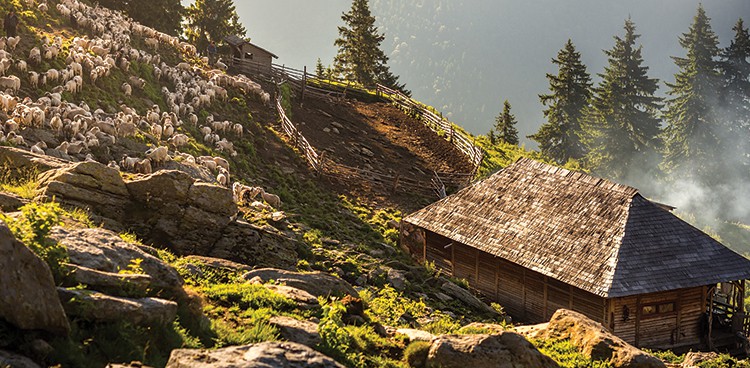
Carpathian Spring is featured in our Spring 2017 issue. Learn more about Romania and its cheesy dishes and check out our dining, activity, and lodging recommendations in the region.
To get to the heart of the Carpathian Mountains, you’ll depart urban Cluj-Napoca on a crammed minibus that snakes around gorges and teeters over passes on potholed dirt roads for hours. Grassy pastures and plum orchards gradually give way to snowy peaks and craggy rocks blanketed with pine forest. Hamlets dotting the hillsides here feel eons away from Cluj’s glitzy shopping malls and bustling nightlife. At first, they seem quiet.
Yet Romanian villages can be louder than cities. Day and night dogs bark, roosters crow, and elderly ladies in colorful headscarves chitchat as they head to the fields, sickles slung over their shoulders.
And then there’s the cacophony of hooves, as sheep, goats, and cows traipse through streets, nudged by grunting shepherds (ciobani) as they ascend to mountain pastures. Society here has long revolved around the movement of these men, who, in search of green grass, once traversed Carpathian peaks hundreds of miles south to the Balkans and as far north as the Caucasus, spreading a distinctive mountain culture as they moved and mingled. Today they’re ubiquitous in songs, paintings, and photos: lone ciobani on the mountain donning cojocs, the long sheepskin cloaks that double as beds during the nights they sleep outside in fields and forests on those seasonal journeys.
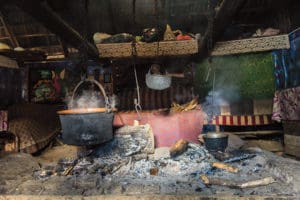
A rustic cheesemaking room in the stână. Photo credit: rusu ioana/Shutterstock.com
Yet twenty-first-century life—its border controls, private property, and strict animal welfare laws—has discouraged that semi-nomadic lifestyle; only a few remaining shepherds still venture far. In winter most live in valley villages and then spend summers high in the surrounding mountains in stânăs—huts made of old wood with thatched roofs. There they herd and milk fellow villagers’ animals, crafting a sheep’s milk cheese called caş.
They do it without pasteurization or shiny equipment; milk flows from animals into wooden buckets, ready to be coagulated with lamb rennet and cut into curds with rustic wooden tools. After forming balls of curd, the shepherds slice them into pieces and knead them back together—a stretching practice with historical ties to Balkan kashkaval and Italian caciocavallo. Wheels of finished cheese, ranging in size from softballs to beach balls, hang in canvas cloths outside. They are ready to eat after three or four days but can be aged weeks longer on wooden planks.
Caş is made throughout the Romanian mountains. In summer you’ll see giant wheels perched on little tables on the side of the highway or in rural markets, alongside other treats produced with sheep’s, cow’s, or goat’s milk, or a blend of milks, from the stână: fluffy urdă, a whey cheese, and fresh golden unt (butter). You’ll find gritty, pasty brânză de burduf: caş chopped into tiny pieces, mixed with salt, and then placed in a sheep’s stomach—or, in the southwestern mountains, a tube of fir bark—to age. Gamy and pungent, these cheeses are unlike anything else. After tasting them, even the most worldly turophiles will be left wondering: Why didn’t we hear about Romanian cheese sooner?
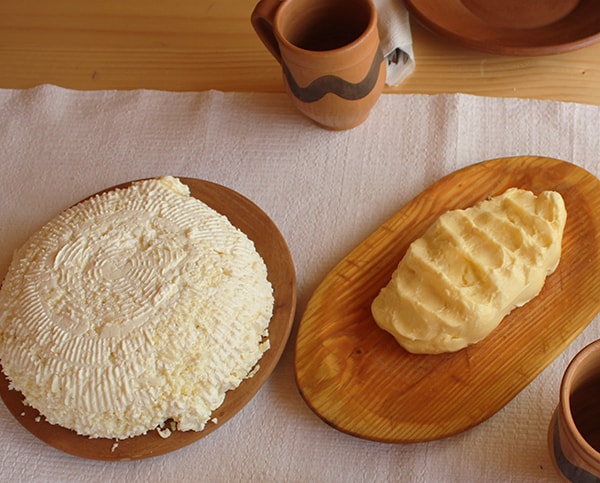
Homemade cheese and butter at Pensiunea Anca. Photo credit: Molly McDonough.
A Hidden History
When English novelist Bram Stoker imagined a setting for a vampire castle, his thoughts turned to the thick fog so common in rugged Romanian highlands. Those “great masses of greyness,” he wrote in Dracula, “threw into strange relief the ghost-like clouds which amongst the Carpathians seem to wind ceaselessly through the valleys.” His 1897 novel would bring fame to “one of the wildest and least known parts of Europe,” a region with a mystique that largely came from its unfamiliarity. Unlike the well-trodden ranges of Europe’s west, these mountains were remote, their dense woodlands home to the continent’s greatest density of bears and wolves.
Behind that mystique lies a violent history. For thousands of years a string of conquerors (Romans, Austro-Hungarians, Ottomans) vied for control of Romania’s three historic regions: Transylvania, Moldavia, and Wallachia. In the Carpathians that divided them, isolation was a survival strategy. After World War II even Nicolae Ceauşescu’s infamously harsh Communist dictatorship struggled to dominate mountain communities. As peasants all over Romania were forced off their land and sent to work in giant state-run factories or farms, the highlands harbored pockets of fierce resistance.
When Communism met a bloody end in the 1989 Romanian Revolution, the outside world peered into the country for the first time in decades—and found it in shambles. And while Ceauşescu’s dictatorship had been oppressive, the transition to capitalism was also grim; as government farms throughout the country collapsed, families returned to the tiny plots of land they’d owned generations earlier and resumed subsistence farming. The agricultural system was fragmented. There was no public or private investment in technology and little opportunity for economic growth. When it finally joined the European Union (EU) in 2007, Romania was one of the most impoverished member states.
A close examination of the dairy sector highlights the consequences of a messy capitalist transition. Soon after Communism’s fall, companies moved in from Western Europe, built factories, and started churning out mass-produced cow’s milk cheeses. “Today most big cheese producers [in Romania] are not Romanian,” says Felix Arion, director of AgroTransilvania Cluster, a Cluj-Napoca-based nonprofit that works to improve market opportunities for small producers. Focused on an economy of scale, “these German or Dutch companies are not interested in making traditional cheese.” And those mountain cheeses, the caş and the urdă made in dilapidated huts? Unable to scale up, reach urban markets, and conform to European regulations, the future of cheesemaking shepherds has become increasingly uncertain.
New Europeans
As one crosses into Romania from the west, the sprawling crops of a mostly flat Hungary give way to a patchwork of hillside homesteads, each boasting diverse crops, orchards, hay bales, grapevines, roaming chickens, and some livestock. With an average farm size of about five acres—compared to Hungary’s 21, or Germany’s 135—it’s clear that subsistence agriculture still reigns here. That might be an obstacle to modernization, but it’s not all bad news; in recent years environmentalists have praised Romania’s “high nature value” grasslands. Lacking access to fertilizers, chemicals, and modern machinery, farmers here have sustained the continent’s most botanically diverse hay meadows—a landscape that in most other parts of Europe has been lost.
And joining the EU has equipped Romania with some new tools to preserve that biodiversity— such as funding for rural development projects that help protect and promote traditional foods. Some of those resources have been channeled toward adopting geographical indications, the system that certifies and protects cheeses such as Parmigiano Reggiano and Gruyère. Getting the most exclusive label, a PDO (Protected Designation of Origin), requires proof of a food’s uniqueness and its historical ties to a region. Ultimately the mark can lead to prestige that helps artisan producers survive. Last year Romania celebrated its very first PDO for a crumbly mountain cheese called Telemea de Ibăneşti, which is brined in saltwater from a local mine.
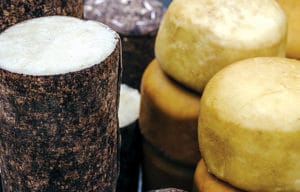
Cheeses at the market, including bark-wrapped brânză and wheels of caş. Photo credit: Florin Cnejevic/ Shutterstock.com.
One PDO product might pale in comparison to Italy’s 165 and France’s 98, but luckily there are countless unique Romanian cheeses with potential, says Arion. He cites the cow’s milk washed-rind năsal, aged in a Transylvanian cave, where it develops a unique bacteria-coated surface. There’s also brânză de burduf în coajă de brad, made from chopped and salted caş that’s stuffed in a long tube of Carpathian fir bark and aged for up to a year.
The main challenge in securing a PDO—or simply getting a cheese into the supermarket—is a lack of infrastructure. To build one, small producers need to work together. But the trauma of communist collectivization has left a lingering fear of association. “When people hear the word ‘cooperative,’ they run away,” says Radu Rey, an advocate for Romanian mountain communities who founded the Carpathian Development Research Institute.
But in the Carpathians, where villagers have long merged animals for high-altitude herding, there’s hope. In a sunny pasture above the village of Fărcaşa, I meet Costel Bondrea, president of a local shepherd’s association. For its first five years, the group had a hard time recruiting members. But in 2008 he teamed up with the nongovernmental organization Heifer International to offer an incentive: Farmers who joined would get a free sheep. “People started to notice we could collect milk, we had an office, and they came to us for support,” Bondrea says. When the organization started leasing communal pastures in 2009 and making a profit, membership skyrocketed.
We’re celebrating the opening of the shepherds’ new stână. Unlike most others in Romania, this one has electricity, running water, and enough space to satisfy EU regulations. The caş made here will be packaged under the new De la Munte (“of the mountain”) label, ready for sale in urban grocery stores. Because six different associations from around the Carpathians own the brand, pooling their resources will help expand its reach. As for the cheese’s commercial appeal, Bondrea is optimistic: “People see the label, and they know that it comes from the mountains, so it’s natural,” he says. “They know animals here only eat mountain grass—that’s all.”

Sheep owners milk their animals at a springtime “Measurement of the Milk” fest near Cluj. The yield determines how much of the Alpine cheese each household will receive during the summer grazing season. Photo credit: Oana Raluca/Shutterstock, Inc.
Visitors Welcome
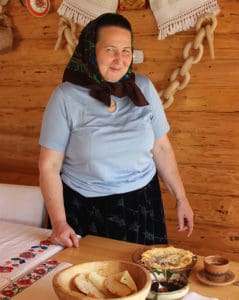
Irina Bozai serves breakfast in Maramureş. Photo credit: Molly McDonough.
Despite projects like Bondrea’s, 98 percent of the sheep dairy market in Romania remains informal. Most cheeses made in the mountains are for immediate family or to trade among villagers—and not by tax-paying businesses. As a result, “not all Romanian traditional products have market potential,” says Arion, AgroTransilvania Cluster director.
The best advice for tourists, then? Stop by someone’s kitchen for the most authentic wedges and wheels. Luckily some of the EU funding that went to support rural development has been channeled into bolstering agritourism. Now that hundreds of farms have opened spare rooms to guests, the Carpathian lifestyle is more accessible than ever.
“In the mountains there’s an aging population with less education and very low income,” says Iulia Muresan, who studies the socioeconomic effects of agritourism at the University of Agricultural Sciences and Veterinary Medicine of Cluj-Napoca. “But tourism represents a chance: It has offered employment, especially for women, while preserving traditional farming.” Staying in Romanian houses, “you can learn something new,” she continues, “[such as] how homemade sausage or cheese is made. Maybe you can help make the cheese, preserve fruits and vegetables, and make wine.” Organic without being certified and grass-fed because the animals have always eaten grass, the wares grown or made on these little farms lack labels but burst with flavor. So often, I find myself marveling at the way old women can turn out culinary masterpieces using banged-up pans, dull knives, and tiny propane stoves.
One evening I’m sipping some homemade plum brandy with Vasile Lenuta in his farmstay near the mountain village of Sadova. He greets me like most Romanians I meet: with reservation and skeptical curiosity. Not yet accustomed to tourism and still grappling with a traumatic past, locals often wonder why an American would venture here. But before long, Lenuta’s enthusiasm shines through; as I nibble on a plate of balmoş, a porridge-like mixture of polenta and his homemade caş, he watches with anticipation and pride. Soon he’s waxing poetic about Romanian sheep and mountain grasses.
“The people here in Sadova, they live to be 90 years old. Or longer! Do you know why?” he asks. After refilling our glasses, he leans forward and points conspiratorially to the heaping platter that sits between us.
“It’s because we are always eating this balmoş,” Lenuta says, “and it’s full of cheese.”
Feature photo credit: egyjanek/Shutterstock.com



